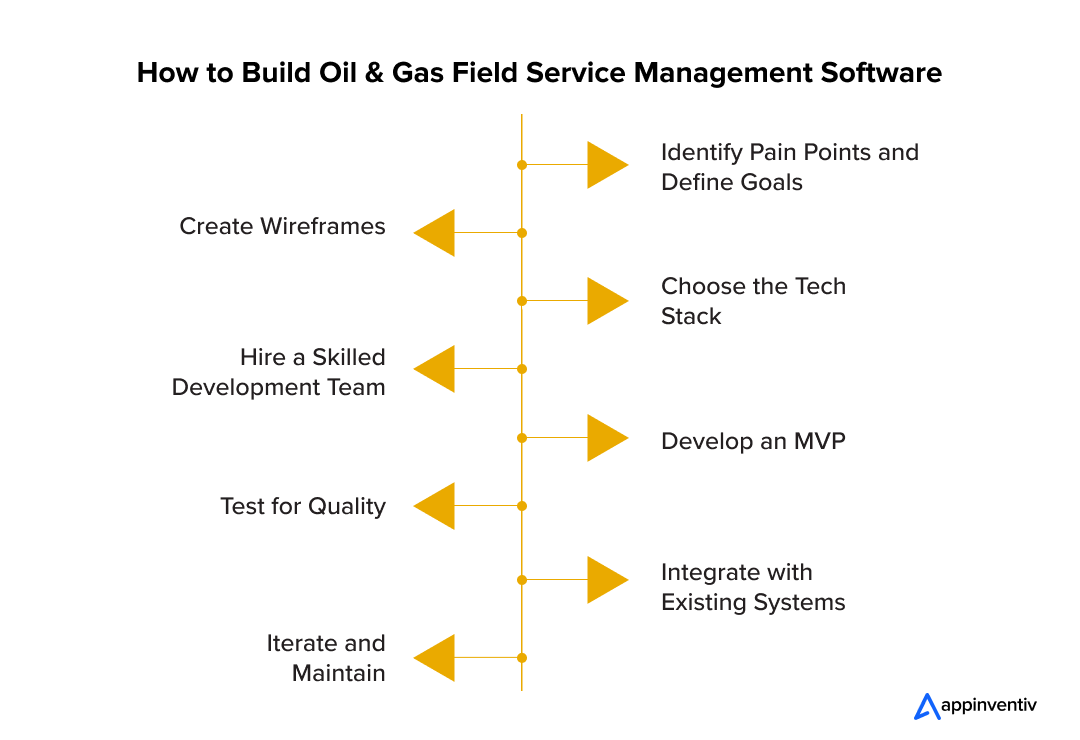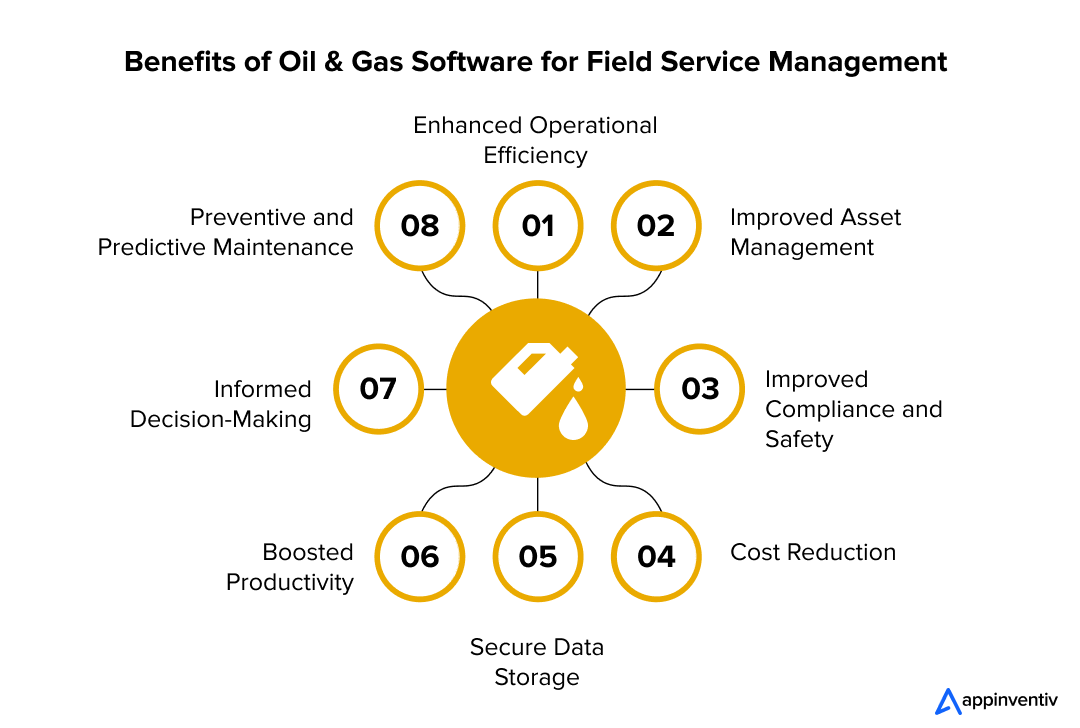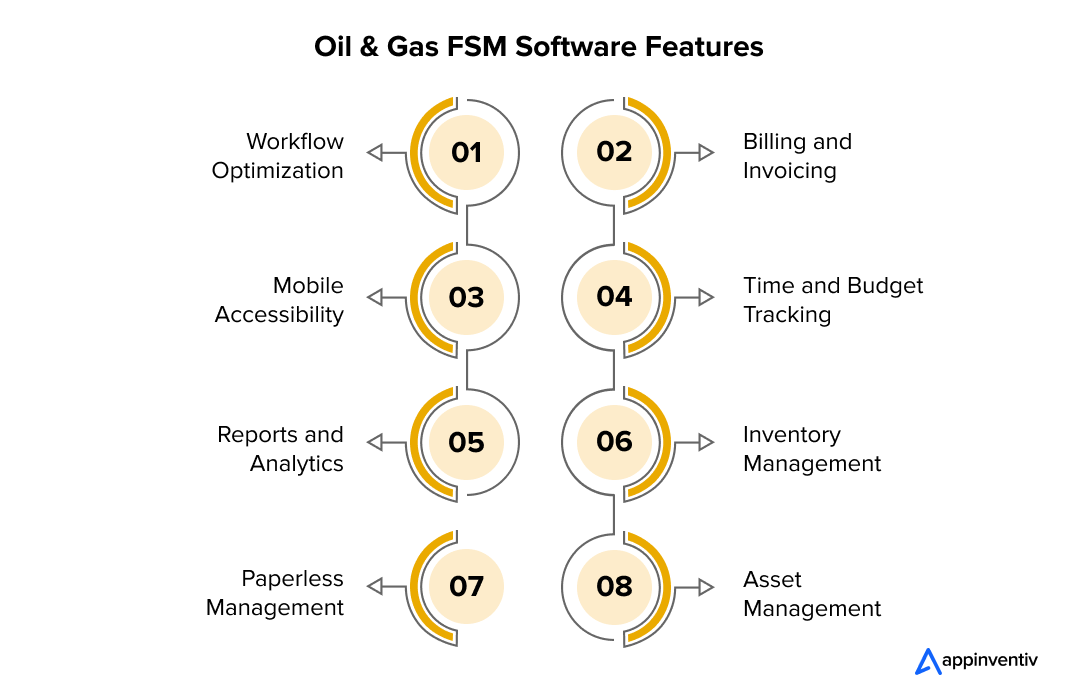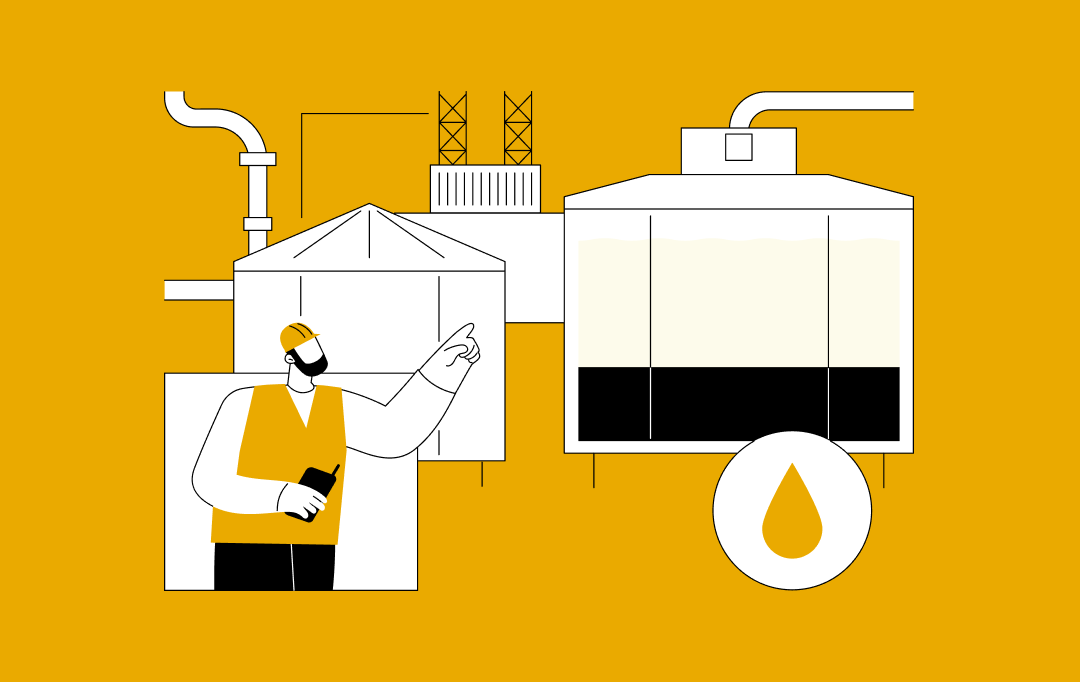- Oil and Gas Field Service Management Software Development Process
- Identify Pain Points and Define Goals
- Create Wireframes
- Choose the Tech Stack
- Hire a Skilled Development Team
- Develop an MVP
- Test for Quality
- Integrate with Existing Systems
- Iterate and Maintain
- Oil and Gas Field Service Management Software Development Cost
- Benefits of Oil and Gas Field Service Management Software
- Enhanced Operational Efficiency
- Improved Asset Management
- Improved Compliance and Safety
- Cost Reduction
- Secure Data Storage
- Boosted Productivity
- Informed Decision-Making
- Preventive and Predictive Maintenance
- Essential Features of oil and gas field service management software
- Workflow Optimization
- Billing and Invoicing
- Mobile Accessibility
- Time and Budget Tracking
- Inventory Management
- Paperless Management
- Reports and Analytics
- Asset Management
- The Future of Field Service Management Software for Oil and Gas
- Appinventiv: Your Tech Partner for Oil and Gas Field Service Management Software Development
- FAQs
The oil and gas businesses are witnessing immense transformations in today’s digital landscape, fueled by innovative software solutions and advanced technologies like AI, IoT, and ML. These technological advancements have blurred the line between geographical borders, empowering businesses to scale their operations globally easily.
Yet, managing and optimizing oil and gas operations across remote locations presents real challenges. From tracking inventory levels to maintaining records and monitoring business progress, staying on top of these critical elements can be daunting. As oil and gas companies face the challenge of managing widespread field assets, monitoring real-time data, and ensuring seamless coordination across locations, custom oil and gas field service management software development is becoming essential.
With its precise documentation, reporting, real-time tracking, and other capabilities, the software empowers businesses to stay proactive, ensuring efficiency and control over their central and remote operations. What’s more? A well-designed field service management (FSM) software for oil and gas also helps streamline operations, improve decision-making, and reduce operational costs.
However, building field service management software for oil and gas is a complex yet critical process. But worry not. This blog will explore the oil and gas field service management software development process, associated costs, features, and benefits, helping businesses embark on their oil and gas field service management software development journey with clarity and confidence.
Oil and Gas Field Service Management Software Development Process
Developing effective field service management software for oil and gas is a challenging endeavor that demands the expertise and time of skilled software developers. To help you succeed in this venture, here is a detailed step-by-step guide for creating robust oil and gas field service management software:

Identify Pain Points and Define Goals
The first step of the oil and gas field service management software development process starts with identifying your specific project needs and defining the goals. Whether it is about improving real-time monitoring, automating task scheduling, managing field services, or enhancing equipment maintenance, clear objectives help guide the development process and ensure the final product meets operational needs.
Create Wireframes
Wireframing is the blueprint for your software. This step involves sketching your main ideas or a visual structure for the user interface and mapping out key features like job tracking, inventory management, and communication tools. Wireframes ensure the software is intuitive and user-friendly, paving the way for successful development.
Choose the Tech Stack
Choosing the right technology stack is crucial to the success of your custom oil and gas field service management software development. Depending on your business needs, you may have seamless scalability and accessibility. Choose technologies that support robust performance and future-proof your operations.
Hire a Skilled Development Team
Hiring the right oil and gas field service management software developers ensures the final product is built with industry-specific insights and best practices. Their expertise in handling complex challenges like product development, system integration, data security, and real-time analytics is essential to delivering a secure and scalable solution that aligns with your specific operational needs.
Develop an MVP
The next step is developing a Minimum Viable Product (MVP) with core features like asset tracking, job scheduling, and field data capture. This allows you to test the software in real-world scenarios while gathering feedback for iterative improvements. Once the MVP proves successful and funding is secured, you can scale the software for full development.
Test for Quality
The next vital step to develop field service management software is testing, which ensures the software functions as expected. This involves functional testing, bug fixing, and security checks to guarantee the system’s reliability under demanding conditions. Testing ensures your software has no issues and is ready for full-scale deployment.
Integrate with Existing Systems
Seamless integration with your existing systems, such as ERP, CRM, and inventory management, is another vital step of the oil and gas field service management software development process. This step ensures data flows smoothly across platforms, eliminating redundancies and enabling better decision-making across all departments.
Iterate and Maintain
Post-launch, continuous iteration, and maintenance are key to keeping your software updated with the latest features and fixing any issues. Regular updates and improvements ensure the software evolves with your business needs, enhancing its performance and value over time.
Now that we know how to build FSM software, let’s answer the other vital question — how much does it cost to make field service management software for oil and gas businesses?
Oil and Gas Field Service Management Software Development Cost
The oil and gas field service management software development cost typically ranges between $30,000 to $300,000 or more. However, it is just a rough estimate; the actual cost can increase or decrease depending on several factors, particularly the complexity and functionalities of your project.
Here is a brief table outlining oil and gas field service management software development cost based on your specific project complexity and features needed:
| Product Complexity | Average Timeline | Average Cost |
|---|---|---|
| Simple solution with basic features | 4-6 months | $30,000-$50,000 |
| Medium complex platform with Moderate features | 4-9 months | $50,000-$120,000 |
| A highly complex system with advanced features | 9 months to 1 year or more | $120,000-$300,000 or more |
Here are some other vital components affecting the oil and gas field service management software development cost:
- Platform Choice: The intended platform—whether mobile, web, or both—will impact development complexity and cost.
- UI/UX Design: Expenses for UI/UX design can vary based on the level of graphics and animation desired. An intuitive and visually appealing UI/UX typically costs more.
- Technology Stack: The choice of programming languages, frameworks, and libraries directly influences development time and cost.
- Developers Locations: The geographical location of oil field service software providers, their experience, and expertise play a significant role in determining the oil and gas field service management software development cost
- Integrations: Costs can increase or decrease based on the number of third-party services or security features required.
- Post-Launch Support: The total budget to build an FSM software can increase if your oil field service software providers offer ongoing maintenance and post-launch support service.
If the budget is a concern, you can choose to go with a Minimum Viable Product (MVP). This approach allows you to launch a basic version of the software with core functionalities, allowing for iterative improvements based on user feedback and validation of your concept. Additionally, an MVP can help attract potential investors and secure funding for subsequent full-scale development, reducing the financial risk associated with a larger project.
You may like reading: Cost to Build An Oil and Gas Data Management Software
Benefits of Oil and Gas Field Service Management Software
Oil field service management software enables businesses to revolutionize their operations by integrating technology into daily tasks. Here is a brief insight into how adopting FSM software can unlock significant advantages for your business.

Enhanced Operational Efficiency
An AI-powered FSM software in oil and gas helps reduce manual errors, improve response time, and increase efficiency by automating essential tasks such as service scheduling, asset tracking, and inventory management. This enables field teams to focus on more critical activities, ensuring smoother operations across various sites.
Improved Asset Management
The oil and gas industry has to deal with a wide range of assets daily. Oil and gas field service software provides comprehensive asset management with real-time asset tracking and monitoring, empowering businesses to predict equipment failures and optimize maintenance schedules accordingly. This proactive approach prevents costly breakdowns, reduces equipment downtime, and maximizes the lifespan of critical machinery.
Improved Compliance and Safety
Given the high-risk nature of oil and gas operations, strict adherence to safety regulations and industry compliance is essential. A field service management software ensures this by integrating real-time monitoring, flagging potential risks, and generating compliance reports, helping maintain safety protocols effectively.
Cost Reduction
Oil and gas companies can significantly lower operational costs through better resource allocation, reduced downtime, and efficient maintenance planning. This leads to more sustainable operations and improved profitability.
Secure Data Storage
Oil field service management software leverages cloud data storage, ensuring enhanced data protection through advanced encryption techniques. This not only protects sensitive operational data from breaches but also allows for easy access and real-time collaboration across geographically dispersed teams.
Boosted Productivity
Field service management software automates repetitive tasks and provides on-the-go access to critical data, allowing field teams to make informed decisions and respond faster to changing conditions. This ensures timely maintenance, reduced manual errors, and quicker resolution of issues, leading to higher productivity and more effective field operations.
Informed Decision-Making
With robust analytics tools, real-time data, and critical task automation, field managers can analyze employees’ performance, track KPIs, and optimize workflows. This data-driven decision-making process helps enhance strategic planning and, thus, improves business performance.
Preventive and Predictive Maintenance
Oil and gas field service software enables companies to adopt preventive and predictive maintenance strategies. By analyzing data from equipment sensors and historical performance, businesses can identify potential issues before they turn into costly failures. It helps reduce downtime and optimize maintenance schedules, ensuring that assets are serviced correctly.
Essential Features of oil and gas field service management software
Even if there are several benefits of oil and gas field service management software, to leverage the maximum potential of FSM, it is imperative to build it with some industry-specific features. Let’s explore some of the most essential features of oil and gas field service management software:

Workflow Optimization
Workflow optimization is a crucial feature of oil and gas field service management software, enabling organizations to streamline their operations effectively. Businesses can tailor their workflows to meet specific operational standards by automating task allocation. This feature ensures that each process aligns with the unique demands of oilfield operations, enhancing efficiency and minimizing bottlenecks.
Billing and Invoicing
Efficient billing and invoicing are crucial features of oil and gas field service management software. This feature simplifies the billing process after completing a task, ensuring timely payments. It also allows businesses to track services delivered over longer-term contracts, offering insights into resource utilization while helping to streamline expenses.
Mobile Accessibility
Mobile access is a must-have feature for all types of software, and oil and gas field service software is no exception. This feature allows managers to access critical information anytime, anywhere, eliminating delays from waiting for back-office feedback. Also, by minimizing paperwork and enabling digital signatures directly through the mobile app, teams can expedite operational processes, ensuring that businesses run smoothly and customers receive timely updates on their service requests.

Time and Budget Tracking
Time and expense tracking features are necessary for effective field service management in the oil and gas industry. Features such as mobile time tracking allow employees to clock in and out easily, while expense tracking ensures all costs—like travel and materials—are accurately recorded and associated with each job, promoting transparency.
Inventory Management
It is one of the most integral features of oil and gas field service management software that provides real-time visibility into inventory management. By integrating inventory and parts management features into the field service management system, businesses can avoid costly delays caused by parts shortages and ensure efficient asset utilization.
Paperless Management
Managing contracts and paperwork can be cumbersome and time-consuming, which may lead to delays in operations. Thus, field service management software for oil and gas must incorporate features that facilitate a paperless workflow. By transitioning from paper to digital records, businesses can improve efficiency and reduce the risk of lost or misplaced documents. It ensures all documentation is easily accessible and securely stored while meeting regulatory compliance guidelines such as GDPR.
Reports and Analytics
Businesses need robust analytics and reporting capabilities to make data-driven decisions. By collecting data on technician productivity, job duration, and equipment usage, companies can generate valuable reports, detect loopholes, pinpoint areas of improvement, and drive business growth.
Asset Management
Asset management functionality is key for businesses managing significant assets. This feature tracks asset details such as maintenance history, warranties, and service schedules, ensuring that equipment is properly maintained, minimizing downtime, and prolonging asset life.
The Future of Field Service Management Software for Oil and Gas
The future of field service management software in the oil and gas industry is centered on the integration of advanced technologies to streamline operations and improve efficiency. As assets become more complex, companies must adopt smarter, tech-advanced solutions to manage field operations.
The next generation of field service management is all about empowering technicians with connected tools—accessing any asset, anytime, anywhere, with the support of cloud-based solutions.
Currently, technologies such as IoT and predictive analytics are already transforming how field services operate. IoT devices provide real-time data on equipment status. Artificial intelligence and digital twins further enhance productivity by automating workflows and reducing the need for manual intervention.
In the coming years, the O&G industry will witness increased adoption of augmented reality (AR), where technicians can visualize equipment data and repair instructions right in front of them.
By embracing these innovations, businesses can optimize their field service management and gain competitive advantages in the fast-paced oil and gas sector. Evidently, the future of oil field service management software lies in leveraging these digital technologies to create more responsive, data-driven, and connected field operations.
Appinventiv: Your Tech Partner for Oil and Gas Field Service Management Software Development
Today, businesses in the oil and gas industry face immense pressure to optimize operations, schedule services, track asset performance, and deliver exceptional services to their clients. Fortunately, field service management software oil and gas for serves as a comprehensive solution to address all field-related challenges.
So, if you are considering developing such software for your oil and gas business, Appinventiv can be your trusted oil and gas software development company. In our nearly a decade of experience, we have delivered 3000+ successful projects for 35+ industries, including oil and gas, manufacturing, logistics, and more.
Our efficient team of 1600+ tech evangelists possess unmatched excellence and follow the best practices for oil and gas field service software development. From giving initial consultation and developing advanced software solutions to deploying them to the targeted platforms and providing post-launch support, we stand by you at every phase of the oil and gas field service software development life cycle.
Our comprehensive custom software development services will help you get a software solution that meets industry demands, enhances productivity, and reduces costs. Let’s embark on this journey together and turn your vision into reality.
FAQs
Q. What is FSM software in the oil and gas industry?
A. FSM software in the oil and gas industry helps manage work orders, streamline field operations, and create a database of the company’s products, raw materials, and ongoing and upcoming processes for better oilfield operations management.
Q. How much does it cost to develop a field service management software?
A. The cost of developing FSM software typically ranges from $30,000 to $300,000 or more depending on various factors like features, technology stack, platform compatibility, location of oil field service software providers, and so on.
To get a more precise estimate of oil and gas field service software development, discuss your project idea with reputed oil and gas field service management software developers.
Q. What is the timeline for oil and gas field service management software development?
A. The timeline for the complete oil and gas field service software development life cycle can vary widely but usually takes between 4 to 6 months for a basic version, while more complex solutions require six months to a year or longer, depending on the complexity, features, and several other components.
For a more precise estimate of the oil and gas field service management software development timeline, get in touch with our oil field service software providers now.


- In just 2 mins you will get a response
- Your idea is 100% protected by our Non Disclosure Agreement.

Custom Development or White Label Solutions: Which is Right for Your Business?
Key takeaways: 77% of companies are prioritizing digital transformation; the right tech approach is crucial for staying competitive. Custom development offers tailored solutions for unique needs, flexibility, and long-term scalability. Whereas, white-label solutions provide quick market entry, cost-efficiency, and easy customization for standard needs. Appinventiv’s expertise helps you navigate custom development vs white-label to choose…

ERP Integration in Australia - Why It Is Essential and How to Do It Right
Key takeaways: ERP integration enables operational efficiency, reduced costs, and enhanced decision-making. Healthcare, finance, manufacturing, retail, and all the other sectors are benefiting from ERP integrations in Australia. While ERP integration can be costly, ranging from AUD 45,000 - AUD 450,000, it leads to significant long-term savings and scalability. Compliance with Australian regulations is critical,…

Predictive Analytics Software Development - Features, Benefits, Use Cases, Process, and Cost
Key Takeaways Predictive analytics helps businesses shift from “what has happened” to "what will happen," enabling proactive strategies rather than reactive ones. Real-time analytics and AI integration are driving the growth of predictive analytics, making it more accurate, accessible, and critical for business success. Custom predictive analytics solutions can enhance customer satisfaction, reduce costs, and…

















